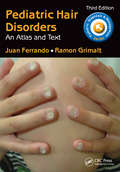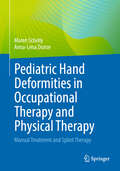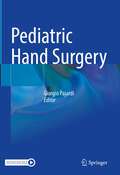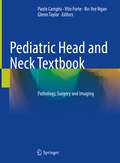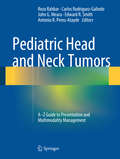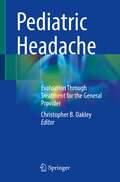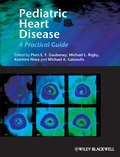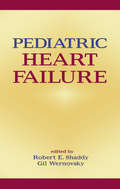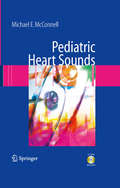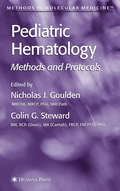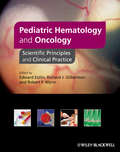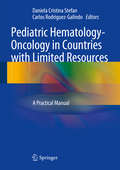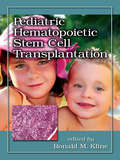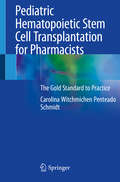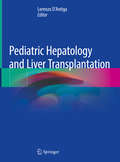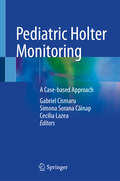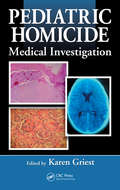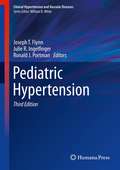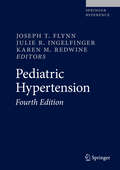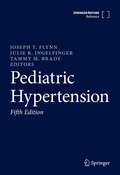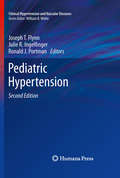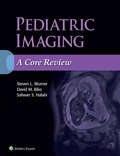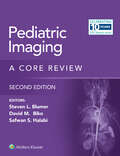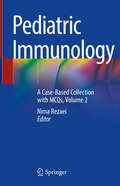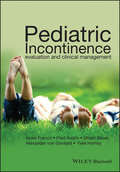- Table View
- List View
Pediatric Hair Disorders: An Atlas and Text, Third Edition (Pediatric Diagnosis and Management)
by Juan Ferrando Ramon GrimaltHair problems in child patients present a particular problem for clinicians: dermatologists, pediatricians, and family physicians can all worry they may not be up to date with what may be happening in the other specialties potentially involved. Written by authors with an international reputation, the new third edition of Pediatric Hair Disorders is full of clinical pictures, with a clear and concise text to help with the diagnosis of each entity. It will be helpful for all clinicians in training and in practice needing a quick and very visual resource to help with clinical diagnosis and to be confident they are using the best recommended techniques.
Pediatric Hand Deformities in Occupational Therapy and Physical Therapy: Manual Treatment and Splint Therapy
by Maren Schelly Anna-Lena DunseThis practical guide provides essential foundations for the treatment of pediatric hand deformities in occupational therapy and physical therapy. How is the function of the deformed hand assessed? When does the intensive manual treatment and splint therapy begin for congenital flexion contractures? From when must manual therapy commence after pollicization? The experts provide you with the answers! From the Content:Anatomical and Motor Development of the HandHand Deformities, including radial longitudinal reduction defect, camptodactyly, and arthrogryposisScar TreatmentOrthotic Care Plus: Additional chapter on tips, tricks, and further informationEmpower your littlest patients for increased independence and quality of life!
Pediatric Hand Surgery
by Giorgio PajardiThis book describes and illustrates surgical procedures of proven efficacy in infants and children with congenital hand deformities, hand traumas, hand dysfunctions due to obstetric palsy of brachial plexus. Essential background information is first provided on anatomy, hand development, and patterns of use. Extensive sections are then devoted to the surgical treatment of trauma to different parts of the hand and each of the relevant congenital conditions. Full guidance on treatment choice is provided, with description of the treatment pathways appropriate in different circumstances and explanation of the impact of patients’ young age on the surgical approach. Readers will learn about the complex features that may be masked even by the simplest congenital condition such as syndactyly and about the implications for treatment. In depth information is also provided on the character and vital role of rehabilitation in the pediatric population. Pediatricians, hand surgeons, plastic surgeons, pediatric surgeons, rheumatologists, neurologists, and physiotherapists will all find that the book improves their clinical practice.
Pediatric Head and Neck Textbook: Pathology, Surgery and Imaging
by Glenn Taylor Paolo Campisi Vito Forte Bo-Yee NganThis book focuses on Pediatric Head and Neck Surgical Diseases and Pediatric Surgical Pathology. The core objective is to provide the reader the essential background of various head and neck diseases that are common and/or unique to children by highlighting the key diagnostic, clinical, and pathologic features. It encompasses a comprehensive spectrum of pediatric head and neck diseases that are congenital or acquired. Many chapters describe the clinical and radiologic presentation, age-specific differential diagnosis, and diagnostic histopathologic features. The clinical and pathologic aspects of diseases that are unique to children and young adults that are amenable to surgical care are specifically emphasized. Pediatric Head and Neck Textbook: Pathology, Surgery and Imaging is aimed at trainees and specialists in Pediatrics, Otolaryngology – Head & Neck Surgery, General and Pediatric Surgery, Pediatric Radiology and Pediatric Pathology.
Pediatric Head and Neck Tumors
by Carlos Rodriguez-Galindo Edward R. Smith Reza Rahbar John G. Meara Antonio R. Perez-AtaydeThe pediatric head and neck cancer patient necessitates a multidisciplinary team of specialists to provide an optimal continuum of care. This A-Z guide provides practical, in-depth information for all medical professionals involved in the evaluation and treatment of these patients. Written in an easy to follow format, each entry contains illustrative figures to aid in pathological and radiographical diagnosis, as well as structured discussion of evaluation and multimodality management. The alphabetical layout eliminates redundancy and allows the busy physician to quickly locate relevant information. Pediatric Head and Neck Tumors is ideal for young physicians as well as attending physicians seeking to expand their knowledgebase to the various subspecialties involved in the multidisciplinary care of their patients.
Pediatric Headache: Evaluation Through Treatment for the General Provider
by Christopher B. OakleyPediatric headache is the most common neurological complaint that presents to the general pediatrician, urgent care and emergency rooms, and to pediatric neurology. Despite how common headaches are in the pediatric population and how many children continue to suffer from their headaches on a daily basis, there remains a tremendous disconnect for those tasked with being the first-line providers (general pediatric providers). This stems from the fact that headache patients can be so variable and challenging, with numerous comorbid concerns, all the while requiring an individualized treatment approach without a cure.The purpose of this proposed book is to help foster a better understanding of how to approach, assess, and ultimately treat pediatric headache for the general pediatric provider in an attempt to make what once was a daunting, overwhelming complaint from patients and their families into something each general pediatric provider can conquer with confidence. With the aid of experts in the field of pediatric headache, this book will begin by providing the foundation as to what types of headaches, primary and secondary as well as their precursors, are commonly seen in the pediatric population. From there, the focus will turn to when should the provider worry about a patient who presents with headaches. The clinic visit -- from the history to the “red flags” to the pertinent exam -- will be reviewed in depth to help distinguish between primary and secondary headaches as well as who warrants an evaluation. Additionally, comorbid concerns will be covered as these may have direct impact on the evaluation and subsequent treatments offered. The next section will delve into the treatment of pediatric headache with a comprehensive approach covering everything from lifestyle to complementary and alternative therapies/treatments, to medications, both acute and prophylactic. Other more specialized treatment options such as procedures and devices will also be discussed albeit these options are more likely to be offered by a specialist rather than a general provider. A subsequent section will highlight the unique challenges for the older adolescent patients as they transition into young adulthood. The closing section will highlight the future of pediatric headache.
Pediatric Heart Disease: A Clinical Guide
by Michael Rigby Koichiro Niwa Michael Gatzoulis Piers DaubeneyA companion book to Adult Congenital Heart Disease that will concentrate on the practical management of children with heart conditions. <P><P>This is aimed at general paediatricians and physicians who are responsible for ongoing management, rather than specialists concerned with acute or rare presentations. The book will be illustrated with relevant radiology scans, demonstrating which investigations are appropriate, and will provide the relevant information for the generalist on patient management for different lesions. A section on emergency management is also included. Authorship is international, with contributions from both sides of the Atlantic and from Japan.
Pediatric Heart Failure
by Gil Wernovsky Robert E. ShaddyThe first book of its kind, this reference describes current diagnostic and treatment strategies for acute and chronic heart failure in the fetus, neonate, child, and young adult-encompassing every aspect of pediatric heart failure including historical perspectives, the latest technologies in mechanical circulatory support, and recent information o
Pediatric Heart Sounds
by Michael E. Mcconnell Alan BraniganPediatric Heart Sounds offers in-depth tutorials of specific pediatric heart sounds and a diagnosis of those sounds. A self-assessment option helps the viewer to recognize the audio features of a heart condition as well as how to analyze logically and 'dissect' the murmur to improve identification. The book is designed to provide explanation of the mechanisms involved.
Pediatric Hematology
by Colin G. Steward Nicholas J. GouldenA collection of cutting-edge methods for investigating and detecting a wide variety of hematological disorders. Here, the reader will find reliable molecular protocols for the diagnosis of Fanconi anemia and dyskeratosis congenita, immunodeficiency, and most forms of hemoglobinopathy. In addition, there are detailed methods for molecular human platelet antigen genotyping, an effective PCR procedure for thrombophilia screening, and protocols for fluorescent in situ hybridization. Since the measurement of minimal residual disease (MRD) provides a much more accurate risk-directed therapy, three methods are presented for detecting residual leukemia below the threshold of light microscopy, along with relatively simple, rapid, and cheap methods for the detection of MRD in ALL and AML.
Pediatric Hematology and Oncology
by Edward Estlin Rob Wynn Richard GilbertsonThis new textbook has an international authorship and is a practical, up-to-date resource for clinicians responsible for the care of children with oncologic and malignant hematologic disease. It is specifically designed for practicing oncologists and hematologists, pediatricians with an interest in childhood cancer and trainees seeking a systematic approach to these disorders. This new textbook has an emphasis on the visual presentation and ease of reading of contemporary and comprehensive information for children's cancers and contains detailed tables, fact boxes and illustrations.The textbook begins with an introduction to the general principles of the scientific foundation and treatment of childhood cancers and hematological malignancies. Separate sections are then devoted to descriptions of central nervous system tumors, hematological malignancies and solid tumors of childhood which encompass epidemiology, cellular and molecular biology, cancer genetics, immunology, pharmacology and the findings of clinical trials. For each area of science covered, key original references and reviews are highlighted to direct further reading.Diagnostic, biological, and therapeutic issues are integrated into each tumor-specific chapter, with evidence supporting the current rationales for risk stratification and the development of novel therapies. A final section then explores supportive care, palliative care, late effects considerations and psychosocial issues as relate to children's cancer.
Pediatric Hematology-Oncology in Countries with Limited Resources
by Daniela Cristina Stefan Carlos Rodriguez-GalindoTypically, manuals of pediatric hematology-oncology are written by specialists from high-income countries, and usually target an audience with a sub-specialist level of training, often assisted by cutting-edge diagnostic and treatment facilities. However, approximately 80% of new cases of cancer in children appear in mid- and low-income countries. Almost invariably, general practitioners or general pediatricians without special training in oncology will look after children with malignancies who enter the health care system in these countries. The diagnostic facilities are usually limited, as are the treatment options. The survival figures in these conditions are somewhere below 20%, while in high-income countries they are in the range of 80% for many childhood cancers. Pediatric Hematology-Oncology in Countries with Limited Resources is the only book of its kind to provide specific guidance applicable to limited resource settings and builds up from the foundation of general practitioner or general pediatrician competence. Written and edited by leaders in the field, this manual educates physicians on the essential components of the discipline, filtered through the experience of specialists from developing countries, with immediate applicability in the specific healthcare environment in these countries.
Pediatric Hematopoietic Stem Cell Transplantation
by Ronald M. KlineHematopoietic stem cell transplantation (HSCT) is currently utilized as a treatment option for a variety of life-threatening conditions affecting children and young adults including leukemia, lymphoma, neuroblastoma, brain tumors, inherited immune deficiency syndromes, blood disorders, and inherited metabolic diseases. This expertly written referen
Pediatric Hematopoietic Stem Cell Transplantation for Pharmacists: The Gold Standard to Practice
by Carolina Witchmichen SchmidtThis unique book is the first on pediatric hematopoietic stem cell transplantation that is especially intended for pharmacists – in recognition of the fact that Pediatric Oncology Pharmacy is an area where more and more specific knowledge is required in daily practice, yet pharmacists who work in pediatric stem cell transplantation do not have a book addressing their specific needs. This pioneering book will likely become the new gold standard for practice, addressing subjects such as stem cells and their differentiation mechanisms; aspects of embryonic and non-embryonic stem cells; stem cell transplantation in pediatrics; stem cell sources and related technical choices; stem cell donors; scheduling transplantations; diseases and chemotherapy protocols that require stem cell transplantation; stem cell homing; engraftment and repopulation of stem cells in bone marrow; autologous stem cell transplantation in pediatrics; allogeneic stem cell transplantation in pediatrics; and indications for autologous and allogeneic pediatric stem cell transplantation. Further, it discusses pediatric graft-versus-host disease and the pharmacist; antibacterial and antifungal prophylaxis; detailed chemotherapy, conditioning and trials for pediatric stem cell transplantation; conditioning granulocyte colony-stimulating factor (G-CSF) in pediatric stem cell transplantation; analyzing prescriptions and programming a pediatric stem cell transplantation; handling chemotherapy and adjuvant drugs for pediatric stem cell transplantation; stem cell transplantation in children up to 1 year old; and clinical pharmacy in pediatric stem cell transplantation. An easy-to-read yet comprehensive guide covering a wide range of topics essential to daily practice, the book offers an invaluable asset for pediatric hemato/ oncology pharmacists, hematologist pharmacists, clinical pharmacists, pediatric pharmacists, pharmaceutical residents and researchers alike.
Pediatric Hepatology and Liver Transplantation
by Lorenzo D'AntigaThis book is the first to provide balanced examination of both pediatric liver disease and liver transplantation – two topics that are inherently related, given that most chronic liver disorders eventually require organ replacement. The different forms of liver disease encountered in the pediatric age group are first discussed in a series of disease-specific chapters that have a reader-friendly, uniform structure covering pathophysiology, diagnostic and treatment algorithms, clinical cases, and transition to adult care. Key topics in the field of liver transplantation are then addressed. Examples include indications and contraindications, surgical techniques and complications, immunosuppression, in pediatric liver transplantation, acute and chronic rejection and allograft dysfunction, and CMV and EBV infection in transplant recipients, long-term graft injury and tolerance. A section on pediatric hepatology across the world includes chapters presenting the features and management of pediatric liver disease in South-America, Africa and Asia. A closing section considers what the future holds for pediatric liver disease and its management, including novel genetic testing, cell therapy and gene therapy. Pediatric Hepatology and Liver Transplantation will be of value for a range of practitioners, from residents making their first approach to pediatric liver disease through to specialists working in transplantation centers.
Pediatric Holter Monitoring: A Case-based Approach
by Gabriel Cismaru Simona Sorana Căinap Cecilia LazeaClinicians have a variety of diagnostic methods available for evaluating a child with an arrhythmia. The ECG and Holter ECG remain the cornerstones for a good diagnostic and a correct management. Many pediatric cardiologists have some experience in Holter ECG interpretation, but many are still uncertain about their ability to recognize normal variants and pathological rhythms. This book is written specifically for pediatric cardiologists and provides a short and practical review of the issue. Following a brief introduction of the theoretical basis of the Holter ECG, the chapters give a systematic method to interpretation of ECG signals. Several print screens from the different softwares are included to assist users in more confidently diagnosing arrhythmias. The book's second part provides a comprehensive collection of real-life cases and Holter ECG tracings in an easy-to-use manner. The cases cover the most common arrhythmias seen in pediatrics and will assist build the skills needed to analyse the Holter ECG quickly and effectively in both infants and older children.
Pediatric Homicide: Medical Investigation
by Karen GriestPediatric homicide investigations are clouded by a number of factors, not the least of which is a lack of straightforward resources. The cause of death in infants and children is often subtle and difficult to establish. Designed for quick access, Pediatric Homicide: Medical Investigation provides an invaluable resource for medical examiners, police
Pediatric Hypertension
by Julie R. Ingelfinger Ronald J. Portman Joseph T. FlynnThis outstanding second edition amplifies and improves this premier text on hypertension in neonates, children, and adolescents. Previous chapters have been fully revised and new chapters have been added to cover important topics of recent interest, such as the metabolic syndrome, the impact of exercise on blood pressure, the many uses of ambulatory monitoring, and the relationship of sleep disorders to hypertension. A comprehensive volume, this book features 32 chapters covering the breadth and depth of the current knowledge. It is divided into 4 sections: blood pressure regulation and hypertension pathophysiology; assessment of blood pressure; predictors, risk factors, and special populations; and evaluation and management. Filled with excellent detail and pragmatic information, Pediatric Hypertension, Second Edition includes therapeutic guidelines from the US National High Blood Pressure Education Program and cutting edge data from clinical antihypertensive trials. Trainees as well as practicing clinicians will find the updated information on current treatments especially useful.
Pediatric Hypertension
by Julie R. Ingelfinger Joseph T. Flynn Karen M. RedwineThe fourth edition of this book is the most comprehensive major reference work on hypertension in children and adolescents. Since the publication of the previous edition, there have been notable changes in the field, with the arrival of new evidence of the long-term sequelae of hypertension in youth, an evidence-based review of the value of routine BP screening in children and adolescents, and further evidence of the cardiovascular consequences of the childhood obesity epidemic. This expanded edition covers these new findings, while featuring new chapters on such timely topics as routine blood pressure screening, hypertension in late adolescents/young adults, and current pediatric hypertension research. The reference work also includes thorough updates on chapters from the previous edition, as well as new clinical practice guidelines for childhood hypertension, which have not been revised since 2004.Written by experts in the field, Pediatric Hypertension, Fourth Edition is the definitive resource for clinicians and researchers interested in childhood hypertension.
Pediatric Hypertension
by Julie R. Ingelfinger Joseph T. Flynn Tammy M. BradyFor the past 17 years, Pediatric Hypertension has served as the definitive reference text on hypertension in children and adolescents. Each edition has incorporated the latest research on the pathophysiology, clinical significance and management of hypertension in the young, and has incorporated the most current consensus guidelines on diagnosis and management. The years since publication of the fourth edition have seen further advances in the field that merit publication of an updated, expanded text, including: Analysis of the implications of updated hypertension guidelines on identification of youth at highest cardiovascular risk Additional data on the proximate effects of high blood pressure in children in adolescents Further understanding of the links between high blood pressure in youth and surrogate markers of adult cardiovascular disease The fifth edition is a readable, informative text that provides a comprehensive guide to the diagnosis, management and therapy of hypertension in children and adolescents, and presents new data that very clearly indicate that the origins of adult cardiovascular disease are rooted in pediatric hypertension. It will, as a result, be very important for therapeutic decisions and will also be highly relevant for those in internal medicine, who care for the millions of adults who have hypertension, cardiovascular disease and kidney disease. In this sense, the book fulfills the longstanding goal of showing that hypertension that begins in childhood is important to track, diagnose and treat, and that the present understanding of adult hypertension necessitates the study of blood pressure in youth. The fifth edition has a similar structural format to the prior editions and covers all aspects of pediatric hypertension, from basic science research to the most recent clinical information.
Pediatric Hypertension (Clinical Hypertension and Vascular Diseases)
by Joseph T. Flynn, Julie R. Ingelfinger and Ronald J. PortmanThis outstanding second edition amplifies and improves this premier text on hypertension in neonates, children, and adolescents. Previous chapters have been fully revised and new chapters have been added to cover important topics of recent interest, such as the metabolic syndrome, the impact of exercise on blood pressure, the many uses of ambulatory monitoring, and the relationship of sleep disorders to hypertension. A comprehensive volume, this book features 32 chapters covering the breadth and depth of the current knowledge. It is divided into 4 sections: blood pressure regulation and hypertension pathophysiology; assessment of blood pressure; predictors, risk factors, and special populations; and evaluation and management. Filled with excellent detail and pragmatic information, Pediatric Hypertension, Second Edition includes therapeutic guidelines from the US National High Blood Pressure Education Program and cutting edge data from clinical antihypertensive trials. Trainees as well as practicing clinicians will find the updated information on current treatments especially useful.
Pediatric Imaging: A Core Review
by Steven L. Blumer David M. Biko Safwan HalabiDesigned specifically to help you succeed on the Core Exam, Pediatric Imaging: A Core Review covers all key aspects of pediatric imaging, mimicking the image-rich, multiple-choice format of the actual test. Ideal for residents getting ready for the Core Examination, as well as practitioners taking recertification exams, this one-of-a-kind review follows the structure and content of what you’ll encounter on the test, effectively preparing you for Core Exam success!
Pediatric Imaging: A Core Review
by Steven L. Blumer David M. Biko Safwan S. HalabiPrepare for success on the pediatric imaging component of the radiology Core Exam! Pediatric Imaging: A Core Review, 2nd Edition, by Drs. Steven L. Blumer, David M. Biko, and Safwan S. Halabi, is an up-to-date, practical review tool written specifically for the Core Exam. This helpful resource contains over 300 image-rich, multiple-choice questions with detailed explanations of right and wrong answers, revised content, and additional eBook questions to ensure you’re ready for the Core Exam or recertification exam.
Pediatric Immunology: A Case-Based Collection with MCQs, Volume 2
by Nima RezaeiThis book comprises a collection of categorized case-based questions, directed and meticulously selected to cover the most common and most important aspects of immunodeficiency diseases. Immunodeficiency disorders of infancy and childhood such as antibody deficiencies, phagocyte defects and defects in innate immunity are addressed among others. Each chapters starts with a brief of the initial presentation and lab data of the patient, followed by a series of 5-6 multiple choice questions (MCQs), leading the reader to the diagnosis and best of practice in a step-wise manner. This MCQ format along with precise, yet detailed answer ensures a quick, case-based, reality learning to the reader. This comprehensive MCQ series, is an essential reading material that a pediatric clinician, hematologist, immunologist, transplant specialist, or pulmonologist, can not afford to miss.
Pediatric Incontinence
by Paul Austin Yves Homsy Alexander Von Gontard Stuart Bauer Israel FrancoPediatric incontinence: evaluation and clinical management offers urologists practical, 'how-to' clinical guidance to what is a very common problem affecting up to 15% of children aged 6 years old. Introductory chapters cover the neurophysiology, psychological and genetic aspects, as well as the urodynamics of incontinence, before it moves on to its core focus, namely the evaluation and management of the problem. All types of management methods will be covered, including behavioural, psychological, medical and surgical, thus providing the reader with a solution to every patient's specific problem. The outstanding editor team led by Professor Israel Franco, one of the world's leading gurus of pediatric urology, have recruited a truly stellar team of contributors each of whom have provided first-rate, high-quality contributions on their specific areas of expertise. Clear management algorithms for each form of treatment support the text, topics of controversy are covered openly, and the latest guidelines from the ICCS, AUA and EAU are included throughout. Perfect to refer to prior to seeing patients on the wards and in the clinics, this is the ideal guide to the topic and an essential purchase for all urologists, pediatric urologists and paediatricians managing children suffering from incontinence.
